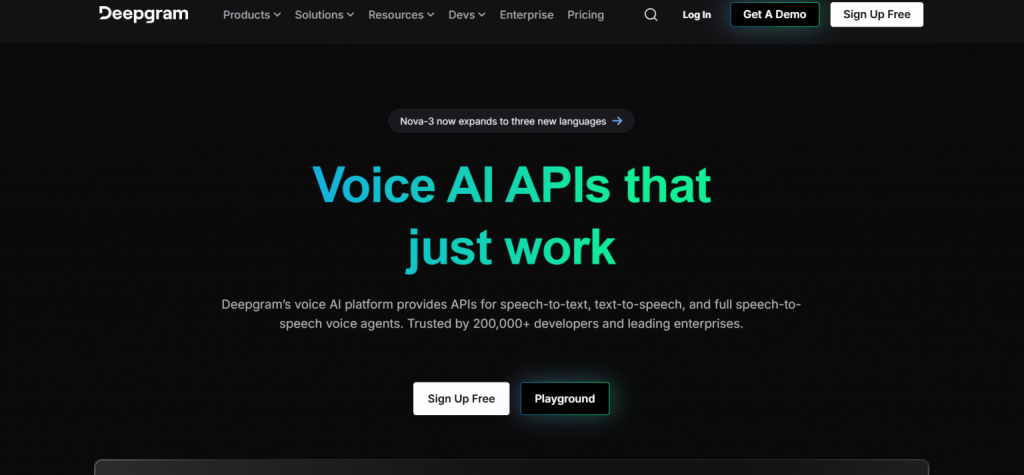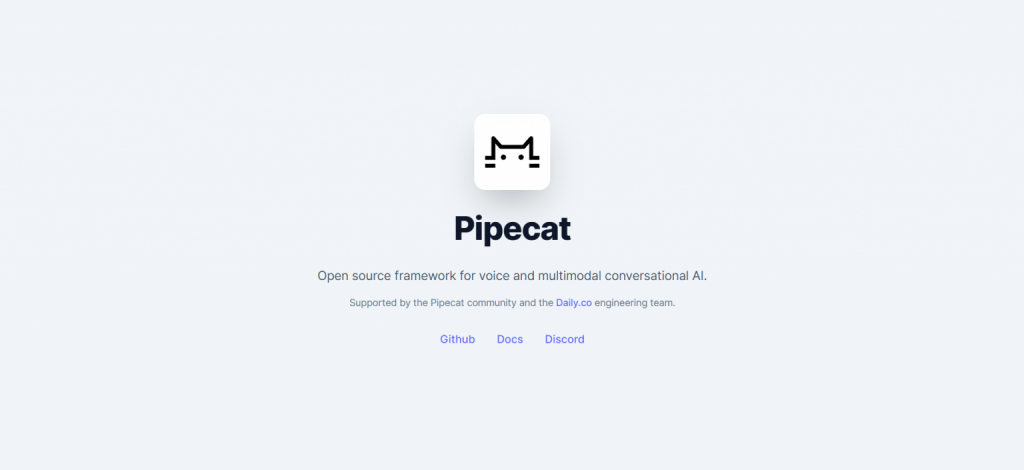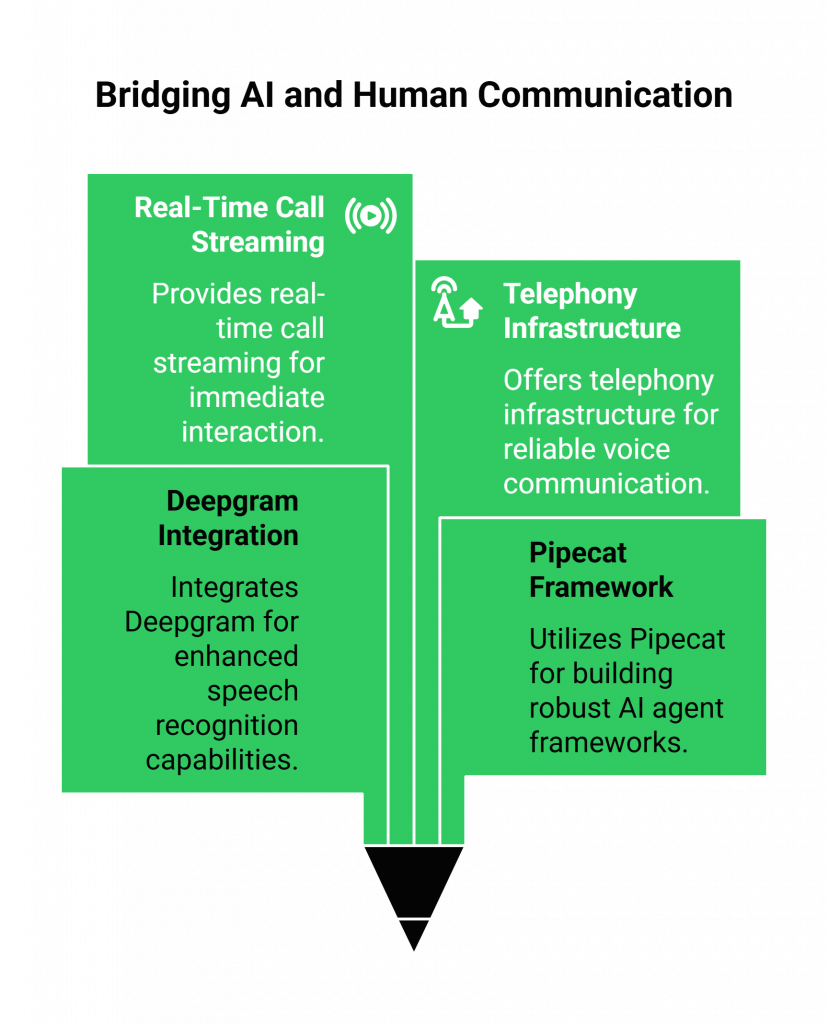For a developer building a voice AI application, the process can feel like constructing a high-performance vehicle. You face a critical decision right at the start: do you need to source the most powerful, specialized engine on the market, or do you need the complete chassis, blueprint, and toolkit to build the entire car from the ground up? This is the perfect analogy for the Deepgram vs Pipecat AI debate.
One is a best-in-class component that performs a single task with incredible precision. The other is a comprehensive framework that lets you build and orchestrate the entire system. Choosing the wrong one for your project can lead to either a lack of control or a mountain of unnecessary work.
This guide will provide a direct, developer-centric comparison of Deepgram vs Pipecat AI, helping you understand their distinct roles so you can choose the right tool for the right layer of your tech stack.
Table of contents
What is Deepgram?
Deepgram is a foundational AI company that provides an API for what many consider to be the fastest and most accurate Speech-to-Text (STT) in the world. Think of it as a powerful, specialized component. You send it audio, and it sends you back a highly accurate text transcript with lightning speed. It is a building block designed to be integrated into a larger application.

Features of Deepgram AI
- Speed and Accuracy: It is purpose-built for real-time streaming, delivering transcripts with extremely low latency, which is essential for any interactive voice application.
- Powerful API: The API is rich with features that developers need, such as speaker diarization (identifying who is speaking), smart formatting, topic detection, and PII redaction.
- Ease of Integration: As an API-first product, it is incredibly simple to use. You make an API call to a well-documented endpoint and get structured data back.
- Scalability: It is a managed service designed to handle massive volumes of audio processing without you having to worry about the underlying infrastructure.
Developers choose Deepgram when they need a world-class “ear” for their application and want the best possible performance for speech recognition.
What is Pipecat AI?
Pipecat AI is an open-source Python framework for building complete, real-time conversational voice agents. It is not an AI model itself. Instead, it is the “workshop” or the “chassis”, a complete toolkit that provides the structure to build a full conversational pipeline. It helps you orchestrate all the necessary components (like an STT, an LLM, and a TTS) to work together seamlessly.

Features of Pipecat AI
- Full Control: As an open-source framework, you have absolute control over every line of code. You can customize any part of the conversational logic to fit your exact needs.
- Model Agnostic: It is designed to work with any service. You can plug in your preferred STT (including Deepgram), your favorite LLM, and any TTS provider you choose.
- Self-Hosting: You run the Pipecat application on your own infrastructure, which is critical for companies with strict data privacy and security requirements.
- No Vendor Lock-in: You are never tied to a single provider’s ecosystem. You own and control your entire application.
Developers choose Pipecat AI when they need to build a complete, custom voice agent from the ground up and want full control over the entire process.
Also Read: How VoIP Calling API Integration for ElevenLabs.io Improves AI Voice Apps?
Deepgram vs Pipecat AI: A Developer-Focused Comparison
This table makes the Deepgram vs Pipecat AI distinction perfectly clear.
| Feature | Deepgram | Pipecat AI |
| Primary Function | Speech-to-Text (STT) API | Conversational AI Framework |
| Core Offering | A powerful AI model as a managed service | An open-source toolkit for building agents |
| Analogy | A high-performance engine | The car chassis and assembly line |
| Hosting Model | Managed Service (Cloud API) | Self-Hosted (On your own servers) |
| Control Level | API-level control over features | Full code-level control over everything |
Why Do You Need FreJun AI?

Whether you are using Deepgram as a component or building a full agent with Pipecat, there is a crucial layer missing: how do you connect this system to a real phone call? This is the specific, focused problem that FreJun AI solves. We are not an STT service or a framework.
We provide the core voice infrastructure, the real-time call streaming and telephony that makes the conversation possible. Our philosophy, “We handle the complex voice infrastructure so you can focus on building your AI,” means we provide the enterprise-grade “plumbing” that allows your Pipecat-built agent to talk to a human over the telephone network.
Also Read: Best Practices for VoIP Calling API Integration with Vapi AI
Use Case Analysis: Making the Right Choice
The right choice in the Deepgram vs Pipecat AI debate depends entirely on the problem you are trying to solve.
Choose Deepgram When
You are building an application where the primary need is to analyze audio, not have a two-way conversation.
- Example Project: A tool that transcribes and analyzes all of your company’s Zoom meetings to create summaries and track action items.
- Why it Fits: You don’t need a conversational agent. You need a fast, reliable transcription engine. Calling Deepgram’s API directly is the most efficient solution.
Choose Pipecat AI When
You need to build a complete, interactive voice agent from scratch.
- Example Project: A custom AI-powered virtual receptionist that can handle complex, multi-turn conversations and needs to be hosted on your company’s private cloud.
- Why it Fits: You need the full orchestration power of a framework like Pipecat to manage the dialogue. You would then use Deepgram within Pipecat as your STT service.
Also Read: Scaling AI Workflows with VoIP Calling API Integration for SynthFlow AI
Conclusion
In the end, the Deepgram vs Pipecat AI comparison is about understanding the different layers of the voice AI stack. They are both exceptional, developer-friendly tools, but they do not compete. They collaborate.
Choose Deepgram when you need a powerful, best-in-class STT component, the “ear” for your application.
Choose Pipecat AI when you need the comprehensive framework, the “workshop” to build and orchestrate an entire conversational agent from scratch.
By understanding whether you need a single, high-performance part or the entire assembly line, you can easily resolve the Deepgram vs Pipecat AI question and choose the right tools to build your next great voice application.
Also Read: SIP Trunk Service: Features Every Business Should Look For
Frequently Asked Questions (FAQs)
Yes, absolutely. This is the most common and powerful way to use them together. Pipecat is designed to be model-agnostic, and integrating a high-performance STT provider like Deepgram is a standard use case.
For a simple transcription task, Deepgram’s API is incredibly easy to get started with. For building a complete conversational agent, Pipecat’s framework provides a helpful structure and clear examples, but it does require knowledge of Python.
No. Deepgram is an STT model, and Pipecat is a framework for orchestrating the AI logic. To connect your agent to the telephone network, you need a specialized voice infrastructure platform like FreJun AI to manage the real-time call streaming and telephony.
The primary advantages are complete control, no vendor lock-in, and infinite customizability. You can modify the code to fit unique requirements and self-host the entire application for maximum data privacy and security.
